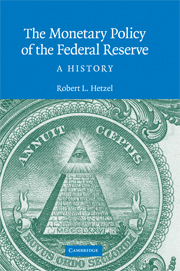Book contents
- Frontmatter
- Contents
- Figures
- Preface
- 1 The Pragmatic Evolution of the Monetary Standard
- 2 Learning and Policy Ambiguity
- 3 From Gold to Fiat Money
- 4 From World War II to the Accord
- 5 Martin and Lean-against-the-Wind
- 6 Inflation Is a Nonmonetary Phenomenon
- 7 The Start of the Great Inflation
- 8 Arthur Burns and Richard Nixon
- 9 Bretton Woods
- 10 Policy in the Ford Administration
- 11 Carter, Burns, and Miller
- 12 The Political Economy of Inflation
- 13 The Volcker Disinflation
- 14 Monetary Policy after the Disinflation
- 15 Greenspan's Move to Price Stability
- 16 International Bailouts and Moral Hazard
- 17 Monetary Policy Becomes Expansionary
- 18 Departing from the Standard Procedures
- 19 Boom and Bust: 1997 to 2001
- 20 Backing Off from Price Stability
- 21 The Volcker–Greenspan Regime
- 22 The Fed: Inflation Fighter or Inflation Creator?
- 23 The Stop–Go Laboratory
- 24 Stop–Go and Interest Rate Inertia
- 25 Monetary Nonneutrality in the Stop–Go Era
- 26 A Century of Monetary Experiments
- Appendix: Data Seen by FOMC for the Stop–Go Period Shown in Figures 24.1, 24.2, and 24.3
- Notes
- Bibliography
- Index
- Titles in the series
8 - Arthur Burns and Richard Nixon
Published online by Cambridge University Press: 26 May 2010
- Frontmatter
- Contents
- Figures
- Preface
- 1 The Pragmatic Evolution of the Monetary Standard
- 2 Learning and Policy Ambiguity
- 3 From Gold to Fiat Money
- 4 From World War II to the Accord
- 5 Martin and Lean-against-the-Wind
- 6 Inflation Is a Nonmonetary Phenomenon
- 7 The Start of the Great Inflation
- 8 Arthur Burns and Richard Nixon
- 9 Bretton Woods
- 10 Policy in the Ford Administration
- 11 Carter, Burns, and Miller
- 12 The Political Economy of Inflation
- 13 The Volcker Disinflation
- 14 Monetary Policy after the Disinflation
- 15 Greenspan's Move to Price Stability
- 16 International Bailouts and Moral Hazard
- 17 Monetary Policy Becomes Expansionary
- 18 Departing from the Standard Procedures
- 19 Boom and Bust: 1997 to 2001
- 20 Backing Off from Price Stability
- 21 The Volcker–Greenspan Regime
- 22 The Fed: Inflation Fighter or Inflation Creator?
- 23 The Stop–Go Laboratory
- 24 Stop–Go and Interest Rate Inertia
- 25 Monetary Nonneutrality in the Stop–Go Era
- 26 A Century of Monetary Experiments
- Appendix: Data Seen by FOMC for the Stop–Go Period Shown in Figures 24.1, 24.2, and 24.3
- Notes
- Bibliography
- Index
- Titles in the series
Summary
In 1969, newly elected President Nixon promised to lower inflation with only a small rise in unemployment. His CEA head, Paul McCracken, promised a return to price stability by maintaining unemployment modestly above 4%. After all, unemployment rates in excess of 4.5% had always been associated with inflation of less than 2%. Surely the economy could move down the Phillips curve just as it had moved up in the 1960s (Stein 1994, 150). The Phillips curve shown in the 1969 Economic Report displayed a clear inverse relationship between inflation and unemployment (Figure 8.1). Had not Samuelson and Solow (1960, 1344) said that the Phillips curve was a “reversible behavior equation”? Nevertheless, even though in 1970 the unemployment rate rose to 5% on its way to 6%, the inflation rate remained near 6%. Samuelson and Solow (1960, 1350) had written: “[I]f mild demand repression checked cost and price increases not at all or only mildly, so that considerable unemployment would have to be engineered before the price level updrift could be prevented, then the cost-push hypothesis would have received its most important confirmation.”
The experiment in “mild repression” begun in 1969 appeared to demonstrate the existence of cost-push inflation. The comments of Samuelson and Solow (1960, 1352) had appeared prescient where they had talked about the high social costs (“class warfare and social conflict”) of controlling cost-push inflation through the creation of unemployment.
- Type
- Chapter
- Information
- The Monetary Policy of the Federal ReserveA History, pp. 77 - 99Publisher: Cambridge University PressPrint publication year: 2008
- 1
- Cited by

